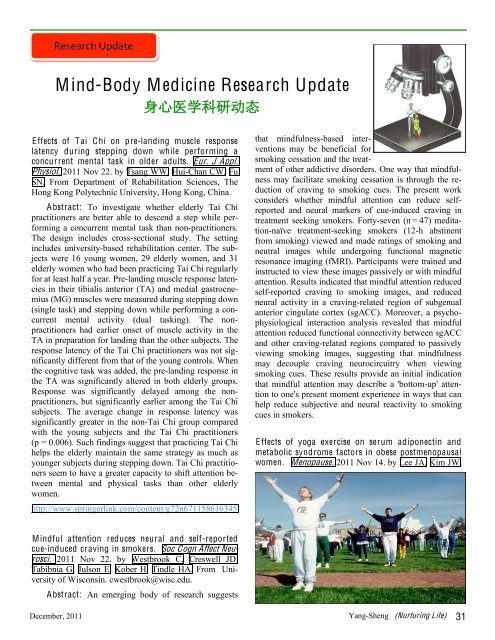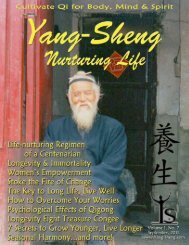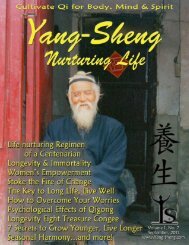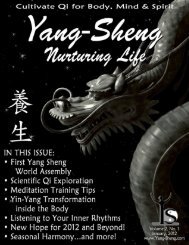Download the December issue of Yang-Sheng as
Download the December issue of Yang-Sheng as
Download the December issue of Yang-Sheng as
You also want an ePaper? Increase the reach of your titles
YUMPU automatically turns print PDFs into web optimized ePapers that Google loves.
Research Update<br />
Mind-Body Medicine Research Update<br />
身心医学科研动态<br />
Effects <strong>of</strong> Tai Chi on pre-landing muscle response<br />
latency during stepping down while performing a<br />
concurrent mental t<strong>as</strong>k in older adults. Eur. J Appl.<br />
Physiol. 2011 Nov 22. by Tsang WW, Hui-Chan CW, Fu<br />
SN. From Department <strong>of</strong> Rehabilitation Sciences, The<br />
Hong Kong Polytechnic University, Hong Kong, China.<br />
Abstract: To investigate whe<strong>the</strong>r elderly Tai Chi<br />
practitioners are better able to descend a step while performing<br />
a concurrent mental t<strong>as</strong>k than non-practitioners.<br />
The design includes cross-sectional study. The setting<br />
includes university-b<strong>as</strong>ed rehabilitation center. The subjects<br />
were 16 young women, 29 elderly women, and 31<br />
elderly women who had been practicing Tai Chi regularly<br />
for at le<strong>as</strong>t half a year. Pre-landing muscle response latencies<br />
in <strong>the</strong>ir tibialis anterior (TA) and medial g<strong>as</strong>trocnemius<br />
(MG) muscles were me<strong>as</strong>ured during stepping down<br />
(single t<strong>as</strong>k) and stepping down while performing a concurrent<br />
mental activity (dual t<strong>as</strong>king). The nonpractitioners<br />
had earlier onset <strong>of</strong> muscle activity in <strong>the</strong><br />
TA in preparation for landing than <strong>the</strong> o<strong>the</strong>r subjects. The<br />
response latency <strong>of</strong> <strong>the</strong> Tai Chi practitioners w<strong>as</strong> not significantly<br />
different from that <strong>of</strong> <strong>the</strong> young controls. When<br />
<strong>the</strong> cognitive t<strong>as</strong>k w<strong>as</strong> added, <strong>the</strong> pre-landing response in<br />
<strong>the</strong> TA w<strong>as</strong> significantly altered in both elderly groups.<br />
Response w<strong>as</strong> significantly delayed among <strong>the</strong> nonpractitioners,<br />
but significantly earlier among <strong>the</strong> Tai Chi<br />
subjects. The average change in response latency w<strong>as</strong><br />
significantly greater in <strong>the</strong> non-Tai Chi group compared<br />
with <strong>the</strong> young subjects and <strong>the</strong> Tai Chi practitioners<br />
(p = 0.006). Such findings suggest that practicing Tai Chi<br />
helps <strong>the</strong> elderly maintain <strong>the</strong> same strategy <strong>as</strong> much <strong>as</strong><br />
younger subjects during stepping down. Tai Chi practitioners<br />
seem to have a greater capacity to shift attention between<br />
mental and physical t<strong>as</strong>ks than o<strong>the</strong>r elderly<br />
women.<br />
http://www.springerlink.com/content/g72n671158616345<br />
Mindful attention reduces neural and self-reported<br />
cue-induced craving in smokers. Soc Cogn Affect Neurosci.<br />
2011 Nov 22. by Westbrook C, Creswell JD,<br />
Tabibnia G, Julson E, Kober H, Tindle HA. From University<br />
<strong>of</strong> Wisconsin. cwestbrook@wisc.edu.<br />
Abstract: An emerging body <strong>of</strong> research suggests<br />
that mindfulness-b<strong>as</strong>ed interventions<br />
may be beneficial for<br />
smoking cessation and <strong>the</strong> treatment<br />
<strong>of</strong> o<strong>the</strong>r addictive disorders. One way that mindfulness<br />
may facilitate smoking cessation is through <strong>the</strong> reduction<br />
<strong>of</strong> craving to smoking cues. The present work<br />
considers whe<strong>the</strong>r mindful attention can reduce selfreported<br />
and neural markers <strong>of</strong> cue-induced craving in<br />
treatment seeking smokers. Forty-seven (n = 47) meditation-naïve<br />
treatment-seeking smokers (12-h abstinent<br />
from smoking) viewed and made ratings <strong>of</strong> smoking and<br />
neutral images while undergoing functional magnetic<br />
resonance imaging (fMRI). Participants were trained and<br />
instructed to view <strong>the</strong>se images p<strong>as</strong>sively or with mindful<br />
attention. Results indicated that mindful attention reduced<br />
self-reported craving to smoking images, and reduced<br />
neural activity in a craving-related region <strong>of</strong> subgenual<br />
anterior cingulate cortex (sgACC). Moreover, a psychophysiological<br />
interaction analysis revealed that mindful<br />
attention reduced functional connectivity between sgACC<br />
and o<strong>the</strong>r craving-related regions compared to p<strong>as</strong>sively<br />
viewing smoking images, suggesting that mindfulness<br />
may decouple craving neurocircuitry when viewing<br />
smoking cues. These results provide an initial indication<br />
that mindful attention may describe a 'bottom-up' attention<br />
to one's present moment experience in ways that can<br />
help reduce subjective and neural reactivity to smoking<br />
cues in smokers.<br />
Effects <strong>of</strong> yoga exercise on serum adiponectin and<br />
metabolic syndrome factors in obese postmenopausal<br />
women. Menopause. 2011 Nov 14. by Lee JA, Kim JW,<br />
<strong>December</strong>, 2011 <strong>Yang</strong>-<strong>Sheng</strong> (Nurturing Life) 31













